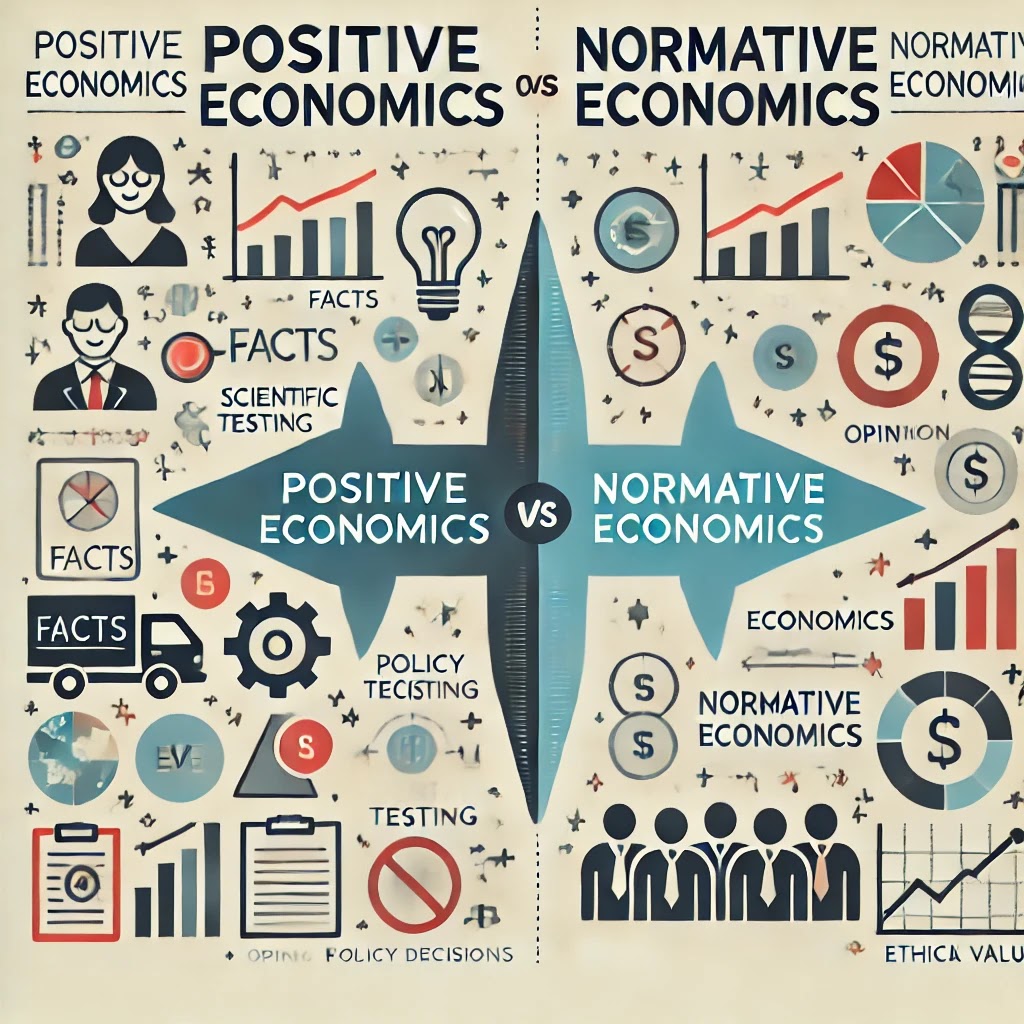Economics is the study of how individuals, businesses, governments, and societies make choices about allocating scarce resources. In this field, the debate between positive economics and normative economics plays a critical role in shaping economic theories, policies, and discussions.
In this post, we will dive into the distinctions between positive economics and normative economics, explore examples, and discuss their relevance in the real world.
What is Positive Economics?
Positive economics refers to the objective analysis of economic phenomena. It deals with facts and cause-and-effect relationships that can be tested and verified. Positive economics does not involve judgment or values; it is purely about explaining how the economy works based on empirical evidence and data.
For example, when economists analyze the effects of an increase in taxes on consumer spending, they are engaging in positive economics. They will look at existing data, statistical trends, and economic models to draw conclusions about how tax rates impact economic behavior, without making any recommendations on whether the tax rates should be raised or lowered.
Key Features of Positive Economics:
- Objective: Based on facts and data, not influenced by opinions.
- Testable: Hypotheses can be tested using empirical data.
- Descriptive: Explains what is happening in the economy, not what should happen.
- No Value Judgment: Focuses on “what is” rather than “what ought to be.”
Example of Positive Economics:
An economist might state: “An increase in the minimum wage leads to a reduction in the number of low-skilled jobs in certain sectors.” This statement is based on observed data and can be tested with real-world evidence.
What is Normative Economics?
Normative economics, on the other hand, involves value judgments about what the economy should look like. Unlike positive economics, it is subjective and rooted in beliefs, ethics, or opinions about what is desirable for society. It is concerned with issues such as equity, justice, and welfare. Normative economics is not something that can be tested or proven scientifically; it reflects what individuals or societies think ought to happen in economic situations.
For instance, a normative economic statement might be, “The government should increase the minimum wage to ensure all workers earn a fair income.” This is not based on data or observation but on a value judgment about what the economy should achieve—fair wages for workers.
Key Features of Normative Economics:
- Subjective: Based on opinions, values, and beliefs.
- Non-testable: Cannot be proven or disproven through empirical data.
- Prescriptive: Suggests what the economy “ought” to be like.
- Value-laden: Focuses on judgments about how the economy should function.
Example of Normative Economics:
A politician might argue: “We should implement a progressive tax system to reduce income inequality.” This is a normative statement because it involves a value judgment about what should be done to achieve a fairer society.
Key Differences Between Positive and Normative Economics
While both positive and normative economics deal with economic concepts, their objectives, methods, and conclusions are distinctly different. Below is a comparative table to help clarify these differences:
| Feature | Positive Economics | Normative Economics |
|---|---|---|
| Objective | Describes what is or what has happened. | Suggests what should happen or what ought to be. |
| Basis | Based on empirical data, facts, and observation. | Based on values, opinions, and beliefs. |
| Testability | Hypotheses can be tested and verified. | Cannot be tested scientifically. |
| Focus | Explains cause and effect in the economy. | Focuses on economic goals and policies. |
| Example | “Higher interest rates lead to lower investment.” | “The government should subsidize renewable energy.” |
Applications of Positive and Normative Economics
Understanding the difference between positive and normative economics is essential for forming clear, rational policies and decisions. Let’s look at how both branches apply to real-world situations:
Positive Economics Example: In climate change economics, a positive economist would study data on carbon emissions, global temperatures, and economic output to understand the relationship between environmental degradation and economic growth. They might use models to predict the effects of different policies, such as carbon taxes, on the economy. Their goal is to provide insights based on facts and analysis, not to argue for or against particular policies.
Normative Economics Example: When discussing income inequality, a normative economist might argue that the government should take action to reduce the wealth gap. They may advocate for policies such as wealth redistribution through progressive taxation or welfare programs. These suggestions are based on beliefs about fairness and justice rather than empirical evidence about the effectiveness of such policies.
The Role of Positive Economics in Policy Making
In economic policymaking, positive economics plays a crucial role. Policymakers rely on data, models, and scientific evidence to understand the potential consequences of their decisions. For example:
- Policy Evaluation: Positive economics helps policymakers evaluate the potential outcomes of various policy options, such as changes in interest rates, tax cuts, or subsidies.
- Economic Forecasting: Positive economic models are used to predict future economic conditions, helping governments plan for issues like inflation, unemployment, or growth.
However, while positive economics provides the data and analysis, normative economics is what shapes the decisions about what should be done with that information.
The Role of Normative Economics in Policy Making
While positive economics tells us what will happen if a policy is implemented, normative economics helps answer the question: What should be done? Normative economics is especially important in areas like social welfare, income redistribution, and ethical policy-making. Governments rely on normative economics to balance economic growth with fairness, justice, and public welfare.
For instance, when considering a social safety net or healthcare reform, normative economics helps to define the goals of those programs (e.g., universal coverage, fair access to resources) based on the values of society.
Challenges and Criticisms
While both positive and normative economics have their place, there are several challenges:
- Overlapping Areas: In practice, positive and normative economics often overlap. Economic policies that are based on data (positive economics) may still be influenced by normative beliefs. For instance, a positive economist may show that reducing taxes increases investment, but a normative economist may argue that the benefits of tax cuts should be targeted toward the lower-income population.
- Bias in Normative Economics: Because normative economics is based on subjective opinions, it can sometimes lead to policies that favor certain groups or ideologies over others. This is often seen in political debates over fiscal policy, social welfare, and environmental protection.
- Challenges of Empirical Testing: In positive economics, data can sometimes be incomplete or inaccurate, leading to flawed conclusions. Policymakers must be cautious when interpreting data and models, particularly in areas like climate change or economic forecasting.
Conclusion
Both positive and normative economics are fundamental components of economic theory, each serving a unique role in the study of economics. Positive economics is essential for understanding and explaining the cause-and-effect relationships within the economy, providing objective insights that can guide policymakers. Normative economics, on the other hand, helps us make value judgments about what should be done to improve societal welfare and equity.
For a balanced and effective approach to policy-making, both branches must be carefully considered. By combining the facts and predictions of positive economics with the values and goals of normative economics, policymakers can create policies that are both effective and aligned with the societal values they aim to support.





One thought on “Positive vs. Normative Economics: Understanding the Differences”